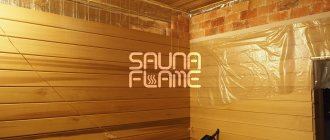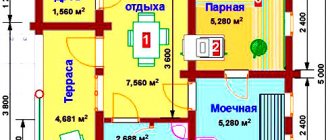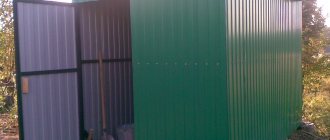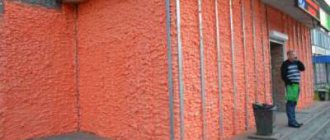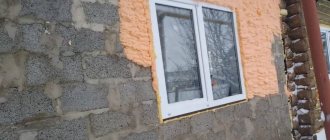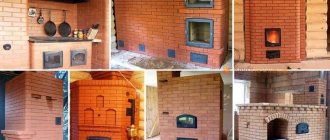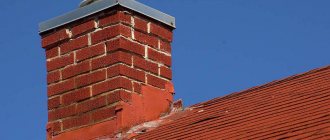Slowly, but Russians are still saying goodbye to small-sized apartments in Khrushchev-era buildings, where a 3-room apartment is often smaller in area than a modern one-room apartment. More and more large private houses are appearing. At the same time, we are talking not only about cottages in elite villages. As the living space increases, heating costs also increase. Proper thermal insulation of all structural elements of a building can save household finances, and therefore homeowners approach the choice of insulation very responsibly. After all, the slightest mistake is fraught with unpleasant consequences in the future.
Taking into account the increased attention of consumers to the topic of thermal insulation materials, the editors of the StroyGuru website have prepared a series of articles about modern types of insulation materials, their characteristics, advantages and disadvantages, and the best manufacturers. In this work we will tell you everything about polyurethane foam insulation, its liquid version, which among builders is called for short - polyurethane foam.
Types of polyurethane and their features of application to coatings
Before you understand the types of insulating materials, you need to understand what polyurethane foam is. This is a composition formed from two components: diisicyanate plus polyol. They are mixed in strictly equal proportions. If there is an excess in the amount of one or another of the two compositions, the technical characteristics that should manifest themselves during the operation of the insulation will suffer.
Application of polyurethane foam on plywood Source odstroy.ru
The components are mixed by placing them in a special high-pressure chamber. Both substances individually are considered toxic, but when they are combined, a completely harmless mixture appears. That is why the material can be used in residential conditions without unnecessary worry. During this process, carbon dioxide is formed, which is actually responsible for the ability to retain heat.
There are several types of polyurethane foam composition:
- Open cell. This is a lightweight type of material, and in appearance it can be confused with mineral wool. The raw material is hygroscopic, but costs more than mineral wool. If you use this type of raw material, you will additionally have to take care of the steam and waterproofing of the layer on all sides. The open-cell version is successfully used for insulating internal partitions and ceilings. For outdoor conditions, it is better to refuse to use this type of polyurethane foam.
- Closed cell. An ideal option for insulating a house from the outside; it is applied to any surface except polyethylene and is not hygroscopic. Additionally, it is divided into several varieties: medium density (28-32 kg/m3), medium density to eliminate cavities, high density (40-80 kg/m3).
Open-cell polyurethane foam for insulation Source stroiliderinfo.ru
What is polyurethane foam
A new type of insulation for Russia, polyurethane foam, is rapidly expanding its niche in the construction market. Poor knowledge of the characteristics of the material, aggressive advertising by manufacturers and anti-advertising of competitors have led to the fact that this material is full of myths and conjectures, among which not only ordinary consumers, but also professional builders are lost.
This is what foamed two-component polyurethane looks like.
The problems start with terminology. By polyurethane foam insulation, many understand foam rubber, familiar to everyone from childhood. But this is a soft and very elastic type of polyurethane foam, which can be used to insulate entrance doors in a building, but not structural elements. Real insulation is in liquid form.
But even here, consumers and experts make inaccuracies, considering simple polyurethane foam to be the same as polyurethane foam insulation. At first glance, they are right: both materials are made of polyurethane foam. But there is still a significant difference. PPU insulation consists of two components: “A” - polyol and “B” - polyisocyanate. When mixed, they enter into a polymer synthesis reaction with the release of carbon dioxide. The result is a foamed material with a rigid structure and closed cells. Polyurethane foam can be purchased in barrels or pre-filled cylinders.
Polyurethane foam consists of one component, which, when exposed to air, comes into contact with water vapor (which is why there is a recommendation to wet the surface before applying foam) and polymerizes with oxygen, creating open cells of frozen foam. Hence the completely different physical and technical indicators. To make it clear what we are talking about, we present a table with the main characteristics of the materials.
Table 1. Main indicators of polyurethane foam and polyurethane foam.
| Types of polyurethane foam / Indicators | PPU | Polyurethane foam |
| Thermal conductivity, W/(m×°K) | 0,022-0,035 | 0,025-0,045 |
| Number of closed cells, % | More than 90.0 | Less than 50.0 |
| Change in foam volume compared to the beginning of the expansion process | 1 in 40 | 1 to 70-90 |
| Vapor permeability, mg/(m*h*Pa) | 0,02-0,05 | 0,07-0,17 |
| Density, kg/m3 | 20,0-80,0 | 8,0-18,0 |
| Moisture absorption,% | 1,0-3,0 | 10,0-60,0 |
| Compressive strength, kgf/cm2 | 1,53-10,19 | About 1.02 |
| Bending strength, kgf/cm2 | 3,3-19,37 | About 17.0 |
One type of polyurethane foam is polyurethane foam.
The next myth is that the insulation is new, little studied. Therefore, it is better to give preference to a well-tested, albeit not the best, heat insulator.
Indeed, in Russia this type of insulation began to be used only in the mid-90s of the last century. It is finding its niche with difficulty, since consumers still prefer traditional insulation materials: expanded clay, glass wool and basalt fiber wool.
The late appearance of PPU in the CIS countries does not at all mean that it appeared in the countries of Europe and North America at the same time. There it has been known since the late 30s of the 20th century (invented by the German chemist Otto von Bayer). Today, the lion's share of the insulation market in the USA and Europe is occupied by two-component polyurethane foam.
Pros and cons of using
The PU foam material has both advantages and disadvantages. To many, these characteristics may seem significant, so we do not recommend ignoring this section. Let's start with the positive qualities:
- PPU insulation can be considered the most effective;
- seamless continuous connection that leaves no chance for the cold;
- sprayed even on surfaces with complex shapes (log walls);
- low level of hygroscopicity (of course, if it is not an open-cell structure);
- ideal adhesion to various materials and surfaces;
- long-term operation (as mentioned above, it can last 25 years if it is a closed-cell material);
- the service is checked in the first year (if no problems with the surface occurred during this period, then they will not arise the rest of the time);
- the application process does not take much time and at the same moment is carried out efficiently, without omissions;
- It is not subject to combustion, as it has self-extinguishing properties.
Applying a thin layer of polyurethane foam Source etalonteplo.ru
There are also several disadvantages that should also not be overlooked. These include:
- too overpriced. This insulation will cost the owner twice as much as mineral wool including installation;
- the need to use high-quality equipment for application. The final result depends on this;
- insulation is difficult to do with your own hands due to the need to have special equipment;
- is susceptible to ultraviolet radiation, since under its influence the structure of the dried foam darkens and collapses.
One can still argue about the last drawback. The fact is that if the thickness of the polyurethane foam is sufficient, then the sun's rays will not completely destroy it. A two- or three-layer application of polyurethane foam can be left even outdoors without applying a final finish.
Application of several layers of polyurethane foam on metal profile walls Source 9dach.ru
Application area
Liquid two-component polyurethane foam serves as an excellent insulation material for any structural elements of frame, brick, block and panel buildings, since its low weight does not create serious mechanical loads on house structures, including lightweight ones.
Good adhesion of polyurethane foam with all building materials allows you to spray insulation on vertical and inclined surfaces: facades, roofing, walls inside the house, ceiling. Excellent thermal insulation properties coupled with fairly high moisture resistance make this type of insulation attractive for thermal insulation of country houses, attics, balconies, floors (along joists). Low level of moisture absorption - foundation.
Attention: the use of the material under compressive loads reduces the thermal insulation effect to zero, and therefore polyurethane foam is not sprayed under the screed and “wet facade”.
Polyurethane foam insulation is also used in other industries. It is used to insulate freezers and is sprayed onto pipes of heating systems. Recently, in industrial construction they have begun to use ready-made sheet material for sandwich panels, when liquid polyurethane foam is poured into molds at the factory.
Features of the device kit for carrying insulation
Application of polyurethane foam to the surface requires the use of special equipment. Before purchasing it, you must make sure that all components are available. These include:
- cylinders for forming foam with liquid inside (2 pieces);
- a spray gun from which foam will be released;
- hoses connecting the gun and cylinders;
- interchangeable nozzles for guns of various modifications;
- component keys necessary for assembling equipment;
- technical lubricant.
Since coating polyurethane foam surfaces is considered a difficult task, and special equipment is expensive, special services have to be involved in the process. If there is an appropriate sprayer unit on the farm, the main thing is to connect it correctly.
Gun variant used for polyurethane foam Source onlinetrade.ru
Manufacturers and prices
Experts call the following companies the best producers of polyurethane foam:
BASF Polyurethanes GmbH. The German company is a leader in the production of polyurethanes. The product line also includes polyurethane foam. In Russia, together with OJSC Nizhnekamskneftekhim, they created the Elastokam enterprise to produce components for polyurethane foam.
Yantai Wanhua Polyurethanes Co., Ltd. Chinese manufacturer with a high-quality line of polyurethane foams.
SYNTHESIA INTERNACIONAL SLU The Spanish chemical company SYNTHESIA INTERNACIONAL SLU has been producing polyurethane foam since 2008. The products have found their buyers in many countries around the world, including Russia.
The price from all manufacturers is about $650 per 1 m3.
Safety precautions when spraying polyurethane foam on the facade
When applying insulation to walls, be sure to follow the rules below.
Before starting work, you must ensure that you have special clothing. Any work uniform or special disposable suit will do.
Respirators and protective gloves must be present, because if the composition gets on exposed skin, there is a danger of burns.
Protective suit for spraying polyurethane foam Source remontik.org
Thermal insulation of one-story and multi-story buildings
Polyurethane foam is a universal insulation material that can be used to insulate absolutely all structures, be they frame, brick, panel, block or wood. It is only important to take into account the severity of the loads on mechanical structures. An insulating substance is applied to the internal and external facades of the walls.
It is necessary to understand that for wooden, brick and concrete walls it is necessary to create an additional frame for the cladding. It is on this that the façade panel and other similar facing material are then attached.
If there are inclined elements, there is no need to worry about the adhesion of the material to them. Polyurethane foam hardens well on them, and does not spread to the side.
Technology for insulating the façade of a house with polyurethane foam
The facade of the house is insulated using standard instructions, which are described step by step below:
- We assemble the equipment, then open the valves and wait for the mixture to flow through the hoses to the sprayer.
- We pull the trigger and point the gun at the wall that needs to be insulated. We distribute the composition evenly over the entire area of the partition.
- We apply polyurethane foam strictly starting from the bottom; if there is a sheathing, then first we fill the voids under it.
- We place the gun so that it is at a distance of no more than 25 cm from the facade of the building.
- We move the gun evenly, without sudden jerks. This way there is every chance of getting a perfectly even coating.
- After finishing work on one side of the house, we move to the other, while turning off the spraying and changing the nozzle (since it hardens very quickly when the supply of material is stopped).
- We adjust the spray intensity if we need to make a thinner layer, then we adjust the equipment so that the jet is as fine as possible.
- If the layer thickness is insufficient, wait until the material hardens and apply a second layer on top of it.
- When applying the second and subsequent layers, we monitor the intensity, since the foam can greatly increase in size and go beyond the lathing, and this is unacceptable, since problems with the decorative finishing of the facade may then arise.
Please note that when laying the second and subsequent layers, it is important to maintain the evenness of the coating. Moreover, re-application of foam should be carried out from places where there are polyurethane foam joints.
At this stage, the insulation process has not yet been completed; in order for the heat-insulating material to reliably serve for more than a dozen years, it is secured by reinforcement. How to do this, read in the next section.
Insulation of the external wall of a building using polyurethane foam insulation Source uteplenie-penop.ucoz.ru
Parameters of sprayed insulation
It’s worth saying right away that, as with any other insulation, it is preferable to insulate the walls of buildings from the outside. If you insulate from the inside, the outer wall will freeze. How many defrosting/freezing cycles it will withstand depends on the material, but rarely will such a house last more than 10 years.
When insulating the outside with polyurethane foam, a final exterior finish is required - the surface has a very unattractive appearance. But there are no problems with freezing of the walls, the building will last a long time.
There are no problems with the roof at all. Roofing materials are designed to withstand repeated freezing, so roof insulation with polyurethane foam can be done from the inside, spraying it directly onto the “underside” of the roofing material or onto the sheathing.
Sprayed thermal insulation can be applied to any surface, and the roof can be insulated from the inside
Whether to insulate the house from the outside or from the inside, we figured it out. Now a little about the layer thickness. Insulation with polyurethane foam is usually made of large thickness. This is not due to the fact that small is not enough. Usually, just according to thermal characteristics, an insulation thickness of 2-3 cm is required, but they make it at least 5 cm. This is so that under any conditions the dew point ends up in the thickness of the thermal insulation, and not in the wall material. Since polyurethane foam is non-hygroscopic, it cannot get wet, condensation simply does not occur, and excess moisture is removed naturally due to the vapor permeability of the material.
Facade reinforcement technology with step-by-step guidance
When all the work on insulating the facade of the house is completed, you can begin finishing, but first you need to carry out reinforcement so that the finishing layer fits well on the insulation. The whole procedure will consist of a small step-by-step algorithm:
- Wait until the applied layers of polyurethane dry well, then cut off any excess waves and bumps, and then sand the surface. To do this, use a special attachment for an angle grinder or coarse sandpaper.
- Cut the reinforcing mesh into fragments so that the length of each is equal to the height of the insulated wall.
- Apply the adhesive composition to the surface of the insulation so that it does not extend beyond the dimensions of one piece of mesh. Remove any remaining adhesive using a notched trowel. This is necessary so that small grooves remain on the wall.
- Apply a piece of reinforcing mesh and embed it in the glue, then smooth the composition using a flat spatula. It is important that the entire part is well soaked, this will encourage adhesion.
- After completing the reinforcement of the facade, coat the entire surface with glue again so that its thickness is at least 2 mm.
Then, after the prepared surface has completely dried, you can begin finishing the facade.
Application of polyurethane foam to the basement of the house Source remontnik.ru
Thermal insulation of industrial and technical objects
It is very convenient to fill buildings and structures with volumetric dimensions and shapes with polyurethane foam. The spraying method for volumetric quadrature is the most suitable, since it does not require additional work on fastening and installation. This material is often used to cover the interior walls of refrigeration industrial premises. Most often, they always need to be kept at a high temperature. Polyurethane foam can be used for objects that are exposed to temperatures up to 130 degrees.
There are no restrictions on the use of polyurethane foam, so it is actively sprayed onto log floors. But at the same time, the condition of finding a heat-insulating layer between the beams is met. This is important because there should be no compressive loads. Polyurethane foam can withstand sudden temperature changes, so it is applied to all types of pipes, ventilation shafts and elements of production lines.
How to insulate an attic with polyurethane foam
The attic is insulated with foamed polyurethane foam from the inside. Therefore, it is immediately important to take care of free access of fresh air into the room, since vapors when sprayed have a toxic effect on the body. Then everything is done in stages.
First stage: preparatory
Perhaps the simplest step is preparing the room for insulation work. It includes clearing the attic of unnecessary items that could accidentally be stained with foam. Furniture is removed, and all non-removable objects are covered with plastic film.
Be sure to cover glass surfaces and doors: with cloth or paste over them with newspapers. If possible, the entire process should be carried out in an empty but well-ventilated area. Sealed windows will have to be opened to provide ventilation.
Dismantling of the attic room before insulation Source par-torg.com
Stage two: dismantling
It is important to dismantle the old covering from the ceiling and remove deteriorated insulation. If the premises have not yet been inhabited, then no preparation will be required. The chipboard and slats that make up the attic structure are checked for integrity; if they are damaged, they need to be replaced.
This step also involves removing dust and debris, removing cobwebs in the corners, and then coating the surface with a primer to increase the chances of adhesion.
Preparing the attic before insulation Source remontnik.ru
Advantages of polyurethane foam insulation
Among the main advantages of the material, in addition to low thermal conductivity, the following advantages should be noted:
- excellent sound insulation characteristics;
- moisture resistance (except for open-cell material);
- possibility of application to any type and type of surface, including curved elements and filling voids;
- creation of a heat-insulating layer without seams and joints, which eliminates the appearance of cold bridges;
- high adhesion to any surface - the only exception is polyethylene, but elements from it are rarely used as a building material;
- long service life of the insulation, ranging from 25 to 50 years or more, depending on operating conditions;
- the shortest possible time required for carrying out the work, since the application of insulation, its subsequent expansion and setting occurs quite quickly. In addition, applying insulation by spraying allows you to immediately process large surfaces;
- insulation, in addition to its main task, also performs the functions of corrosion protection for metal elements;
- the low weight of the sprayed material allows it to be used for insulation without creating additional load on the load-bearing structures of the building;
- the insulation is environmentally safe and is not subject to destruction by microorganisms, and also does not require the installation of additional wind, steam or water protection.
It should be noted that, although polyurethane foam is not a non-flammable material, its use is quite safe given its ability to self-extinguish, but it is important to remember that in such cases there is an intense release of poisonous and toxic combustion products.
In addition, you need to pay attention to its high adhesive ability, which is a boon for thermal insulation of surfaces, but in case of contamination of nearby areas that cannot be treated, it can only be removed mechanically, which leads to damage to the latter.
Therefore, before starting work, you should protect all surfaces on which spraying is undesirable.
Disadvantages of PPU
Of the negative properties of the material, it should be noted:
- relatively high price;
- the need to strictly adhere to the technology of performing the work, which creates certain difficulties when applying insulation independently;
- the lack of vapor permeability of the material requires the creation of an effective ventilation system in the room;
- vulnerability to ultraviolet radiation. All surfaces that may be exposed to sunlight must be protected with an outer layer of cladding: a curtain wall, plastering, etc.
Another significant disadvantage is the need to use special equipment and a reliable personal protective kit, consisting of a suit, respirator, and goggles.
In addition, spraying polyurethane foam requires certain skills in working with both the material itself and the equipment.
Therefore, it is often more profitable to invite professional craftsmen for this work, especially taking into account the fact that purchasing equipment for one-time use or renting it is not economically profitable, and it will not be possible to apply thermal insulation manually using auxiliary mechanisms.
But if we are talking about sealing small construction cavities or areas, then it is quite possible to do the work yourself, for example, using polynor , a sprayed material used for heat and sound insulation.
Available in cylinders and does not require special skills to use. Polinor is completely ready for use and is a material in the form of a foamed mass, in which the ratio of carbon dioxide to solid particles is 9 to 1.
The capacity of one cylinder is either 800 mm or 1000 mm - this volume of material is enough to treat an area of 1 to 2 m2, depending on the thickness of the applied layer.
When processing cavities, it should be taken into account that the insulation not only perfectly fills the space, but can also cause damage or even destruction of the structure as a result of the expansion of the material after hardening.
Therefore, such work must be carried out with the utmost care, for example, performing such foam insulation in several approaches.
Features and beneficial properties of polyurethane
When choosing attic insulation using polyurethane foam, you need to know what properties the declared material has. All detailed data will be presented in the table.
| Characteristic | Indicators |
| Thermal conductivity | 0.03 W (m*K) |
| Weight of the insulating layer | 30-70 kg/cub.m |
| Waterproof | Full (for closed cell material) |
| Fire safety | Level G-2 |
| Adhesion | High (for any surfaces) |
| Adjusting layer thickness | Possible during operation |
| Additional functions | Noise insulation |
| Drying time | 1 hour |
| Treatment against rodents and insects | Not required |
| Lifetime | 40-50 years |
Spraying and pouring polyurethane foam (PPU)
If you are currently building a house, then think carefully about its insulation. First of all, think about how much of your future non-guaranteed income will come from heating bills.
Now is the time to make a smart decision - major insulation of your property. It’s better to spend money once and then save for the rest of your life than to save once and then heat the street and pay big bills.
Polyurethane foam - we look into the future with optimism.
With the existing variety of thermal insulation materials, I would immediately like to note the fact that they all have two major drawbacks: fasteners and joints.
In order for the insulation to EFFECTIVELY fulfill its purpose, it must be attached to the surface to be insulated so that there is no air gap left between it and the surface.
Condensation moisture appears precisely in the layer between the insulation and the surface, because This is where the boundary between heat and cold lies.
When installing sheet insulation, special attention should be paid to cracks and joints, otherwise the expenses and labor will be in vain. Moisture will still appear. And moisture means damp walls, increased heat loss and the appearance of mold and mildew.
This is the dew point.
Laying roll insulation on horizontal and inclined surfaces also does not help the situation. It is no coincidence that various vapor barrier materials are included with them. Without these materials, such insulation would quickly become saturated with moisture, cease to perform its function, and collapse within a few years.
But vapor barrier does not solve the problem - it just pushes it back in time. It was created precisely in order to extend the life of mineral wool.
As for curved surfaces (corrugated sheets, metal tiles), it is simply pointless to insulate them with sheet material, and insulating them with rolled material is ineffective due to the same dew point.
After 5-7 years, you can safely open such surfaces and throw away the insulation. Tested in practice. Anyone can verify this by watching videos on the Internet.
Massive advertising of mineral wool manufacturers did its job. This so-called insulation, not created for our climate, has won its share of the market. And sales are based only on the lack of knowledge of physics among our population at the 7th grade level.
You and I do not live in America or Europe, here the climate is different and the requirements for insulation are different.
How does Russia insulate itself?
When property owners are faced with the question of insulation, they have to choose between polystyrene foam, mineral wool or basalt fiber.
Recently, pouring penoizol into the ventilation gap of brickwork has become popular. This once again confirms the fact of blatant technical illiteracy of both customers and performers. The components of Penoizol contain a large amount of water, which remains in the material for a very long time, negating the thermal insulation properties of Penoizol. When drying, Penoizol cracks, forming straight bridges of cold.
In general, people without special education (and these are the absolute majority), when faced with the problem of insulation, use everyday logic. The essence of this logic is to compare insulation with winter clothing. Which is fundamentally wrong.
What do we wear in winter? Sheepskin coats and down jackets.
What protects us from the cold? An air layer that is located between the fibers of wool, down or padding polyester.
Mineral wool and basalt insulation consist of almost the same fibers, and if they are sewn into fiberglass, then this is a real down jacket.
The analogy is inaccurate.
We periodically take off our clothes, excess moisture evaporates, and it is impossible to remove the insulation. Insufficient thickness of the insulation leads to freezing and accumulation of moisture, which destroys both the insulation itself and the surface, which turns from heat-insulating to heat-conducting, which further aggravates the situation. But property owners don't know about this. In 90% of cases, the insulation is not available for control. Some actions begin only after the appearance of mold and mildew.
Why is this happening? Air is the best insulation after vacuum. But STILL air. If the structure of the insulation is such that air flows pass through it, such “insulation” must be protected from saturation with moisture. For our climate, the thickness of such insulation should be at least 20 cm, with double protection and an air gap in front of the outer cladding. 5-7 cm of hard polyurethane foam is sufficient without additional measures.
Foam plastic (expanded polystyrene)
- Article about teaching staff
- Comparison and calculations
Consists of granules foamed under the influence of high temperature.
Thanks to its low cost, it has gained popularity, especially in the Samara region, where one of the largest PPS production plants is located.
Density - from 15 to 40 kg/cub.m.
Thermal conductivity coefficient - 0.04 W/m*
Moisture absorption coefficient - 3-5%
Effective service life is from 5 to 10 years.
It is used everywhere, from insulating balconies to facades of multi-storey buildings.
Almost all modern new buildings are insulated with 10 cm thick EPS, followed by finishing with facade plaster.
Why? Because it's cheap. And because the construction company is then not responsible for anything.
Features that must be observed by workers when applying insulation
When performing work on applying polyurethane foam to walls, the operator must ensure:
- the optimal temperature of the surface on which polyurethane foam is applied is 10 degrees;
- preheating of insulation components to the indicators provided for in the specifications for a specific type of material;
- strict mixing of components in a 1: 1 ratio;
- 100% intensive mixing of the components until a homogeneous liquid consistency is formed;
- uniform spraying and compliance with the thickness of the insulating layer.
On a note! PPU is difficult to dismantle if applied incorrectly. There is a big risk that a piece of foam will fall behind the part of the plaster that covers the wall.
It should be noted that the quality and duration of service after applying a layer of polyurethane foam depends strictly on how correct the material manufacturing technology was. In other words, if the manufacturer approached the process negligently, then you should not expect reliable operation from the thermal insulation composition. This flaw cannot be determined by eye by the appearance of the material. All you have to do is trust the seller.
Application conditions and surface preparation
Even with good adhesion, which is characteristic of polyurethane foam insulation, surface preparation will not be superfluous. First of all, you need to remove everything that is crumbling - and first of all the old paint. Grease stains must also be removed and neutralized. They shouldn't exist.
Polyurethane foam is applied to dry, grease-free surfaces
Everything that should not be covered with foam should be covered with polyethylene secured with tape. It must be secured carefully, without gaps - it is difficult to remove the foam.
When insulating a roof with polyurethane foam, there are two ways to apply thermal insulation. The first is to make a permanent continuous sheathing onto which foam is poured. The second is to make a temporary frame consisting of two parallel planes.
If the outer walls of a building are insulated with polyurethane foam, a finishing finish is assumed. And after cleaning the surface, you need to make sure that you can strengthen it with something - it won’t work with foam. To do this, most often, wooden or metal strips are placed on the walls, to which the exterior trim is then attached. This completes the preparation. But applying polyurethane foam is only possible on a completely dry surface, at temperatures above +10°C. There are no other conditions.
Options for thermal insulation of buildings with polyurethane foam
There are 2 different ways to insulate the walls of a building with this material, differing in thermal conductivity and vapor permeability properties:
- Insulation with rigid polyurethane foam can significantly increase the heat, steam, sound and waterproofing of a house. Spraying thickness varies from 50 to 80 mm. It adheres perfectly to the surface, and all subsequent facing work can begin the very next day. The use of a vapor-permeable moisture-proof membrane in this case is not required;
- The second way to insulate a house is by spraying light polyurethane foam. The main difference from the first option is that the material must be covered with a vapor-permeable moisture-proof membrane, since it is a “breathable” insulation. In addition, a higher thermal conductivity coefficient than that of rigid polyurethane foam indicates that it is applied in a large layer, equal to 100-120 mm.
Dense hard polyurethane foam
Breathable, porous, lightweight PU foam
Some tips
If you still decide to insulate your frame, brick or wooden house with polyurethane foam, then you need to take into account a few tips from professionals:
- insulation of walls and floors using PU foam spraying technology should be carried out only from the outside;
- provide maximum protection of the heat insulator from the outside from moisture, UV, air and monitor its reliability throughout the entire operational period;
- If it is decided to insulate the walls of a frame house with polyurethane foam - filling the voids formed during its operation due to wear and tear of the insulation, then it is necessary to ensure complete tightness of the internal premises, i.e. The wall finishing material should not allow air to pass through;
- When choosing a contractor, you should take into account not only the company’s advertising brochures; it is better to try to find ready-made objects with the longest possible service life.
Attention! The environmental safety of using polyurethane foam in refrigerators is guaranteed by the tightness of its packaging!
Insulation of walls outside a wooden or brick house with polyurethane foam, filling of voids in a frame structure can also be done with mineral wool, polystyrene foam or other material. The main thing is to focus on the characteristics of the structure itself, the features of its operation, and climatic conditions
Insulated PPU timber
Let’s talk separately about a new product that has gained enormous popularity in Europe today. It consists of two lamellas, between which a layer of polyurethane foam is poured. Foaming, polyurethane foam glues the boards together, creating an imitation of real laminated veneer lumber.
Practice shows that a structure assembled from two lamellas and fasteners in the form of polyurethane foam is no different in appearance from a wall made of laminated veneer lumber, but in terms of characteristics, it is many times superior to it. Insulated PPU timber is three times lighter, cheaper and warmer than solid wood. The internal filling of the wall made of polyurethane foam enhances the thermal insulation properties of the timber, and the house does not require additional insulation, which saves money on heating.
Having familiarized yourself with the advantages and disadvantages of polyurethane foam, having considered the types and technology of applying the material, it will be easier for you to make the right choice in terms of insulating your home and soundproofing it. Make the right choice, and your home will delight you with warmth and comfort for many years!
Polyurethane foam: types, properties, application
Why you need to buy linen insulation for your home
Insulation of walls by pouring
In the case when the interior decoration of the house has already been completed, but you forgot to take care of saving heat in the house and the walls from the inside are not insulated with anything, there is a wonderful way to fix this problem by pouring liquid polyurethane foam between the outer wall of the house and the sheathing.
Insulating a house with polyurethane foam has a fairly simple technology; there is absolutely nothing complicated in this process. The most important thing is to correctly calculate the required volume of polyurethane foam that will be needed for each wall.
Pouring polyurethane foam between the outer wall and the sheathing
Calculation
For example, the thickness between the wall and the sheathing is 5 cm , which is a multiple of 0.05 m. Now let’s calculate the area of the insulated wall.
For a room 6x4 m , with a ceiling height of 3 meters, the area of the larger wall is 18 m² .
Now it remains to find out the density of polyurethane foam; it varies from manufacturer to manufacturer. Let's take the most common indicator, which is 32 kg/m³ .
Multiplying the resulting numbers we get 0.05x18x32 = 28.8 kg. or 0.9 liters. Rounding the resulting number, we find that one 6x4 will require approximately 1 liter of raw materials.
Preparation
- On the outside of the house, mark a section of the wall as follows. Draw a conditional diagonal line from any lower corner. At a distance of 50 cm, mark a point on it.
- Next, repeat the same procedure with the second corner. The resulting points formed a segment that must be divided into proportional parts, the length of which will be as close as possible to 50 cm.
- Using the same method, mark the rest of the wall all the way to the top. If necessary, the dimensions can be slightly adjusted.
- Using a hammer drill, drill holes that will serve as filler holes. Use a drill of the same diameter as the spray nozzle.
Important! If the walls are made of brick, then the hole must be drilled into the masonry joint. In block walls, the hole is made in the block itself.
Fill
There is nothing complicated here. Bring the gun to the hole and, starting from the bottom, slowly fill each of them. The required amount of composition that needs to be poured into each hole is also not difficult to calculate. For example, there were 20 ⊗ . We divide the previously calculated volume by the number of holes, we get 1:20 = 0.05 l. or 50 ml. for each hole.
Pouring polyurethane foam between walls
What will the cost of such insulation depend on?
The cost of polyurethane foam insulation will depend on the volume of foam used. The average price per cubic meter of this composition is approximately 10,000-12,000 rubles. This volume is usually enough to process 20 m2, but in rooms with uneven surfaces the consumption may increase.
Features of works on insulating facades with polyurethane foam
Insulation of the facade using polyurethane foam is carried out by spraying. Liquid polyurethane foam is poured into a tank and, using a pneumatic spray gun connected to a compressor, the mixture is applied to the facade under pressure. As it cools, it turns into foam, which fills all the cracks on the facade and then hardens. To ensure good adhesion, the walls must be cleaned of dirt and dust before application. Since the foam does not form a uniform surface, after the polymerization process is completed, the master carefully cuts off the excess so that the cladding can be made with plaster.
Analysis of the material in comparison with analogues
Modern technologies offer many options for insulating facades. Compared to other thermal insulation materials, liquid polyurethane insulation has very high thermal conductivity levels. For example, a layer of 1 cm of polyurethane foam has the same thermal conductivity as 5 cm of mineral wool or 30 cm of reinforced concrete.
We recommend: Do-it-yourself Venetian plaster walls - step-by-step instructions
Figure 2. What liquid thermal insulation looks like.
Unlike expanded polystyrene , which is of course very popular because it is very easy to install, PU foam is extremely difficult to ignite. Thanks to fire retardant additives, even with deliberate arson or prolonged exposure to temperatures above 500 degrees, the material self-extinguishes.
To apply, you do not need to somehow treat or level the surface, and the procedure itself is extremely simple. Even insulating the facade of a large house will take much less time than with other popular insulation materials.
Advantages and disadvantages of insulating facades with polyurethane foam
Polyurethane foam for insulating facades has both pros and cons, which must be carefully weighed before deciding to apply it.
The benefits include:
- The quality of the facade does not matter, since liquid has high adhesion.
- The structure of the material creates monolithic protection of the entire surface.
- High sound insulation properties.
- Resistance to mechanical and chemical influences.
- Due to its liquid state, the substance eliminates the risk of the formation of “cold bridges” near the sheathing.
- Ideal for insulating houses with complex geometry and a large number of parts.
- High parameters of resistance to open fire.
- Due to its low weight, it is suitable for application to buildings with dilapidated foundations, and in addition, it will create additional rigidity for the walls.
- Surface treatment is extremely fast and simple.
- There is no need to use additional vapor barrier or windproof films.
- Resistant to the formation and development of fungal lesions, destruction by rodents or insects.
- Service life is at least 50 years.
The disadvantages include:
- To insulate buildings with polyurethane foam, you need to have special, expensive equipment.
- It is necessary to have special protective equipment: gloves, masks, goggles, overalls.
- Fire safety regulations must be observed.
- The insulated surface of the facades must be covered with finishing materials.
